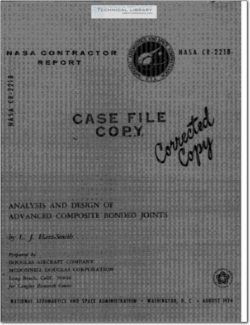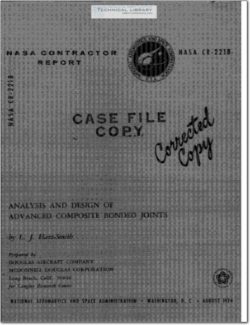NASA-CR-2218

- Version
- 393 Downloads
- 3.72 MB File Size
- 1 File Count
- December 13, 2015 Create Date
- December 13, 2015 Last Updated
Analysis and Design of Advanced Composite Bonded Joints

Advances in the design of adhesive bonded joints are presented in this
report, with particular reference to advanced composite structures. The solu-
tions are largely closed-form analytical results, employing iterative solutions
on a digital computer for the more complicated joint configurations. The joints
.analyzed are of double-lap, single-lap, scarf and stepped-lap configurations.
Tensile, compressive, and in—plane shear load conditions are covered. In addi-
tion to the usual geometric variables, the following joint parameters are
accounted for: adhesive plasticity (using an elaStic—plastic shear stress
model), adherend stiffness imbalance and adherend thermal mismatch. Of these,
the adhesive plasticity increases the joint failure strength dramatically above
the predictions of purely elastic analyses because the maximum lap-joint
strengths are shown to be defined by the adhesive strain energy in shear. Any
dissimilarity between adherends effects a joint strength reduction.
In assessing the joint efficiency, three potential failure modes are
considered. First, for a well-designed joint, the laminate (adherend) will fail
outside the joint. This failure mode is particularly prevalent for single—lap
joints but they should not be considered well—designed because of the eccen-
tricity in the load path. Second, the ultimate shear strain of the adhesive
may be exceeded, resulting in bond failure. This is the usual test case.
Third, the peel stresses induced at the end(s) of the joint may exceed the
interlaminar tension strength of the laminate, causing a splitting failure of
the adherend. (In the case of metal adherends, the corresponding failure is
by peeling the adherends apart.) This third mode applies particularly to thick
section lap joints and occurs for both single—lap and double-lap joints, at
loads far below the potential bond shear strength. A simple modification is
suggested which virtually eliminates the peel—stress problem.
The analyses on which this report is based are documented in four sepa~
rate technical reports, so mathematical derivations are excluded from this
report. The digital computer programs used in preparing the solutions are to
be found in the same references which are in the text. Practical considéra—
tions of design, analysis, and fabrication are also discussed.
| File | Action |
|---|---|
| NASA-CR-2218 Analysis and Design of Advanced Composite Bonded Joints.pdf | Download |
Comment On This Post